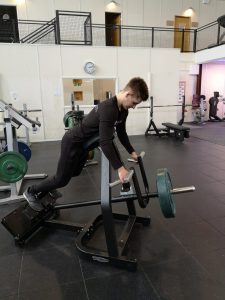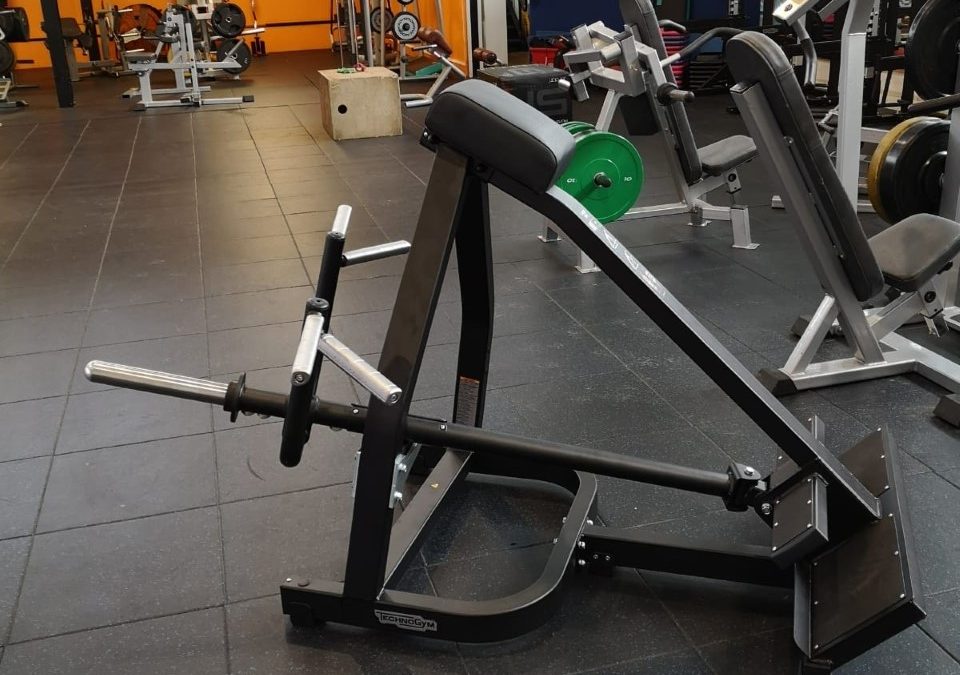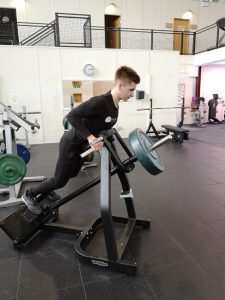Have you seen our new top of the range Technogym T-bar?
Chest supported T-bar Row
Starting Position
- With a slight bend in the knees, find a comfortable position where the T-bar row machine’s chest support pad is pressed against your entire sternum.
- Plant your feet about shoulder width apart on the foot platform. Depending on the particular piece of equipment and how your body fits on it, you may find it more comfortable to simply plant your feet on the floor instead of the platform.
- Reach down and grasp the handles in whichever position is most comfortable.
- Hoist the T-bar off the pin and bring it toward your midline
Position yourself so that your sternum, or “breastbone,” is fully on the pad. You don’t want the lower part of your sternum (near the solar plexus) to jam into the edge of the pad. Not only can that be painful, but it will mess up your form.
Choose whichever grip position you prefer. A wider grip width and/or straighter handles will hit the rear delts a bit more. Whereas, a closer grip width and/or angled handles will hit the lats a bit more.
- Do not relax into the chest support pad. It’s there for support, not to do all the work. You still need to maintain a rigid braced posture.
- Keep a bit of tension through your legs. This will prevent you from sliding down the pad while supporting your rigid neutral posture.
- Actively maintain a neutral cervical spine throughout the lift. Do not flex or extend your neck!
- From a slightly protracted shoulder blade position, initiate an “active shoulder” position by retracting the shoulder blades together, to bring them to their neutral position. You are now in the starting position and ready to begin the lift!
Once you’re holding the T-bar up off the pin on the side of the machine and it is there in the centre, motionless, with your arms straight and shoulder blades in a neutral position, you’re in the starting position and ready to begin the lift.
Concentric Movement
- Pull the resistance with the goal of an upper arm position at about a 45 degree angle in relation to the trunk once you’ve hit the midpoint of the movement.
- Bring the bar as far up as you can until your shoulder blades are touching and your hands are in line with the bottom of your torso (this is the equivalent of touching the bar to your torso on barbell rows). If you can’t do this, the load is too heavy and you need to take some weight off.
- Actively brace the core during the pull.
Pull through your elbows and focus on using your back to do the lifting. Not just your arms.
Midpoint
- Once the resistance has been pulled into the bench, utilise a hard isometric contraction to maximise voluntary muscular force.
- Maintain an active shoulder and an abdominal brace.
Eccentric Movement
- Slowly return the resistance back to the starting position by straightening your elbows and allowing your shoulder blades to come forward somewhat.
- Decelerate as you reach lockout at the bottom.
- Slightly flare the elbows out to return the shoulder to neutral starting position.
- Don’t relax and let the weight fall back towards the ground. Keep it under control the whole time.
- Feel a nice stretch at the bottom. Again, don’t relax. You don’t want the weight hang on your shoulder joints.
Keep the load under control as you lower it. Maintain a neutral posture (including your neck), this means bracing the core and keeping some tension in the legs
Extend your elbows fully and stretch at the bottom. Ease into the stretch; don’t just drop the weight. Also, you don’t want to stretch so much that your shoulders are at risk. Keep some tension and keep the shoulder joint in its socket.
Allow your shoulder blades to glide down, around you rib cage as you embrace a mild to moderate stretch throughout your mid back.
Repeat
- Before you start the next rep, first allow the resistance to settle.
- Retract your shoulder blades from their protracted state, back into a neutral position.
- Complete as many reps as your routine calls for. The best results in are in the higher rep ranges (e.g. 12-20) on this exercise. But you can still get good results going as low as 5. Understand though, for this lift in particular, it becomes increasingly harder to maintain good form as you increase the weight and lower the reps.
TOP TIPS:
- Slightly tuck the elbows during the pull to maximally activate the lats.
- Actively brace the core and slightly tilt the hips forward.
- Pause slightly at the mid point to maximally activate the lats and mid-back.
- Keep the shoulder blades retracted during the entire movement.
- Do not relax during the eccentric phase.
- Go wider and/or use the straight handles to emphasise the rear delts more. Go narrower and/or use the angled handles to emphasise the lats more. Avoid the former if you have any pre-existing shoulder joint or rotator cuff issues.
See tfd’s Ash below demonstrating a the new T-bar Row… If you would like any help using the new t-bar row or with workout ideas, don’t hesitate to grab one of our instructors or book in an appointment to see one of them!

by Damian – Level 3 Personal Trainer


